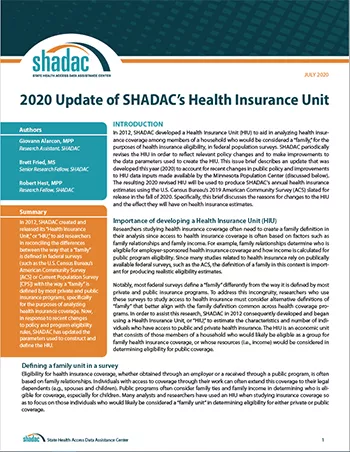In the years following the passage of the Patient Protection and Affordable Care Act (ACA), SHADAC developed and introduced its Health Insurance Unit, or “HIU,” a tool to aid in defining family interrelationships in federal population surveys for the purpose of analyzing health insurance coverage.
Now, SHADAC has revised its HIU in response to recent policy shifts, such as changes to eligibility for public and private insurance programs and changes to how relationships are coded in the federal surveys. A new brief from SHADAC researchers describes the revisions to the HIU, details the associated updates and improvements made to the data parameters used to create the HIU, and shows how this new HIU can be applied to federal survey research.
What is the SHADAC HIU?
Originally released in 2012, one of the goals of the SHADAC HIU is to establish a common definition of a “family unit” to help ensure consistent and comparative research across major national surveys when analyzing health insurance coverage.
Most federal surveys define a “family” differently from the way it is defined by most private and public insurance programs. For instance, the definition of "family" or "household" in U.S. Census Bureau surveys includes all related members of a household, no matter the degree of relationship, and does not necessarily align with dependent coverage or public program eligibility.
The SHADAC HIU attempts to more closely align with a definition of family used for private and public health insurance coverage eligibility. The SHADAC HIU uses a narrower definition of family that looks at specific interrelationships between individuals within a household and excludes all non-dependent relatives (grandparents, adult siblings, aunts/uncles, etc.) who may be household members but are unlikely to be considered as part of the “family unit” as defined for the purposes of determining eligibility for health insurance.
The SHADAC HIU, then, is defined as an economic unit that consists of those members of a household who would likely be eligible as a group for family health insurance coverage, or whose resources (i.e., income) would be considered in determining eligibility for public coverage.
Original vs. Revised: How the SHADAC HIU is constructed
The SHADAC HIU is constructed based on a set of rules for assigning individuals within a household into family groups based on their familial relationships. The updates to the revised SHADAC HIU center around changes to these assignment rules.
The original version of the HIU created “family units” using the following assignment rules:
- single adults with no children of their own living with them are assigned to their own HIU
- married couples with no children of their own living with them are placed together in an HIU
- single or married parents and their eligible children (i.e., children 18 years of age or younger, who do not have a spouse in the household and have no children of their own) are assigned to an HIU
- eligible children with no parent in their household, but who are related to the household reference person are placed in the reference person’s HIU
- eligible children with no parent in the household and who are not related to the household reference person are placed in their own HIU
As a result of recent policy and health landscape changes, the revised version of the HIU creates “family units” using the following assignment rules:
- single adults with no children of their own living with them are placed in their own HIU
- married couples with no children of their own living with them, now including same-sex couples as well as couples who report being separated but still live together, are placed together in an HIU1
- single or married parents and their eligible children (i.e., children 18 years of age or younger, who do not have a spouse in the household and have no children of their own), now including same-sex couples as well as couples who report being separated but still live together are placed together in an HIU1
- eligible children with more than one unmarried parent in the household are now placed in the HIU of the parent with the highest income
- eligible children with no parent in their household, but who are related to the household reference person are placed in the reference person’s HIU
- eligible children with no parent in the household and who are not related to the household reference person are placed in their own HIU
- eligible married children who live apart from their spouse but in the same household as one or more of their parents are now incorporated into the HIU of the parent(s)
Click on the brief to download a PDF and learn more about the revisions to the SHADAC HIU.
Explore current and upcoming data using the SHADAC HIU
While SHADAC’s HIU was originally constructed with the intention to be broadly consistent with the family unit that is relevant for public and private insurance, it is able to be tailored to specific criteria used in individual states, for specific programs, or for specific types of analysis.
Our State Health Compare web tool currently houses estimates produced using the original SHADAC HIU, including breakdowns from the Health Insurance Coverage measure such as income and poverty level.
For more on the original version of the HIU, see our issue brief with more on creation and definitions of the HIU and our technical brief with information, and example STATA and SAS code for using the HIU. Estimates and code using the revised HIU will be available following this year’s U.S. Census Bureau American Community Survey (ACS) and Current Population Survey (CPS) release in September.
NOTES
1 Same-sex couples are now included as of the 2015 ruling by the Supreme Court in Obergefell v. Hodges granting their legal right to marry.
Couples who report being separated but still live together are considered legally married and therefore still considered eligible for coverage under their spouse’s insurance.

